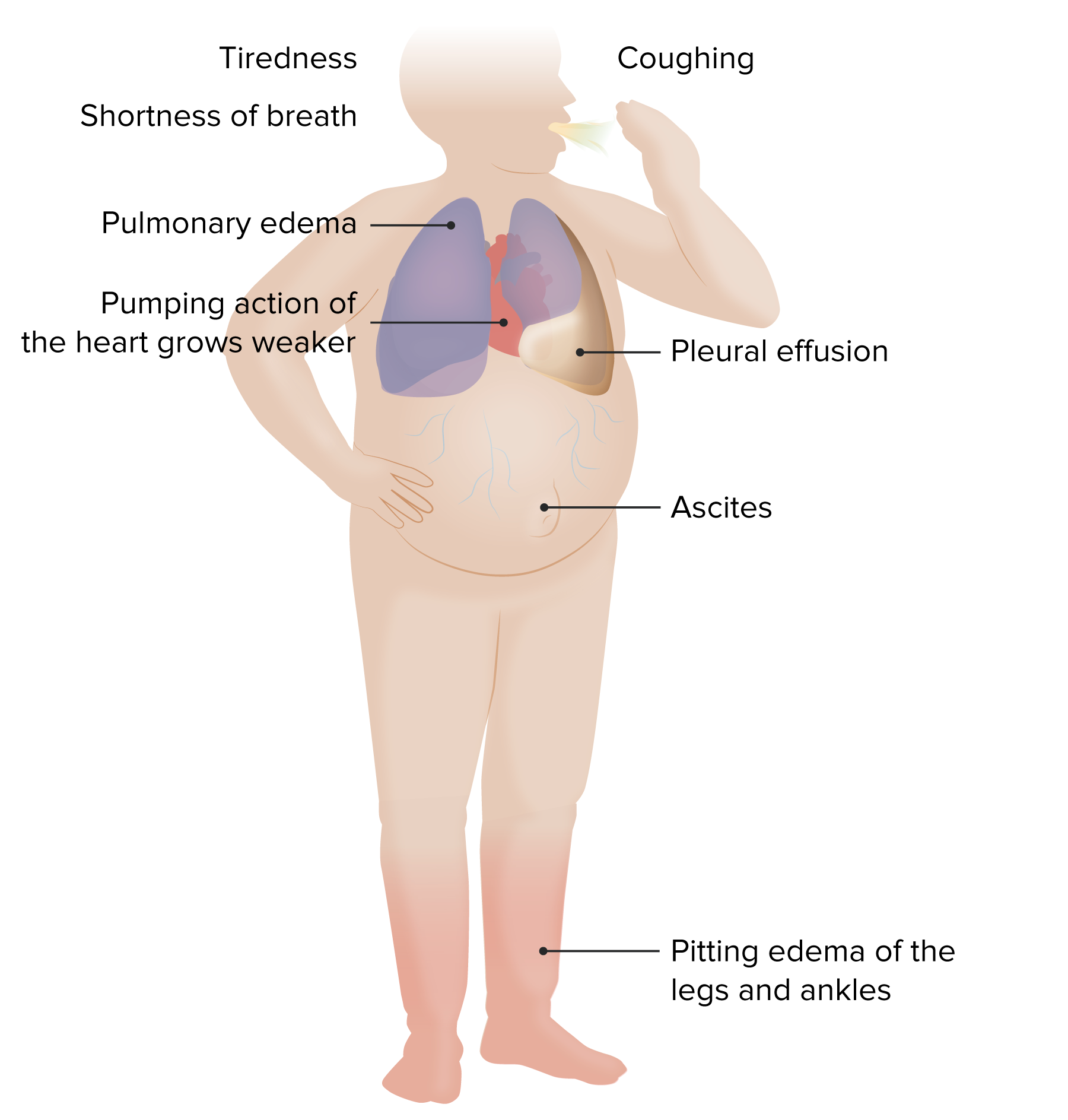Playlist
Show Playlist
Hide Playlist
Heart Failure (HF): Definition
-
Slides CongestiveHeartFailure CardiovascularPathology.pdf
-
Download Lecture Overview
00:01 Now CHF can be described as the following and a couple of things that you want to pay attention here. 00:08 So please follow me. We will begin with the left ventricle. 00:11 The most common side of the heart to be affected would be the left side as you know. Now with CHF, you then divide it into systolic or diastolic dysfunction depending as to what then led up into that particular type of failure. Take your time. If it is systolic dysfunction, I am having a hard time ejecting. If you have a hard time ejecting meaning to say that you can’t contract your heart. How does it occur? Maybe there was a myocardial infarction resulting in ischemia obviously. And so therefore the heart no longer fully recovers its normal action, activity, and function, may result in a systolic dysfunction. Is that clear? When you have a systolic type of dysfunction, you should automatically think and be looking at clinically at least to the point where you know that your left ventricle has been enlarged probably underwent eccentric hypertrophy and PMI was probably what? Laterally displaced. 01:06 Versus a diastolic dysfunction. Now a systolic dysfunction if I can’t even eject the blood forward, what is the test that you are going to measure in which the blood gets ejected or not? It is called ejection fraction. What is that equal? It equals your stroke volume over your EDV. What is your stroke volume? It is the EDV minus ESV/EDV. That is your ejection fraction. It is a fraction, you got a percentage and that would be 55 percent. If it is systolic dysfunction, your ejection fraction plummets immediately. You know without a doubt that your patient has heart failure. Now that is the easy diagnosis. The one that you want to be a little bit more careful is based on history. Everything is based on history. With diastolic dysfunction, it is a very thick left ventricle or maybe perhaps there is too much blood in your left ventricle. Let us deal with the one in which your left ventricular wall is thickened secondary to pressure. Where does this pressure come from? Most commonly hypertension. And what kind of change, what kind of hypertrophy would you have in your left ventricle? Concentric hypertrophy resulting in decreased chamber size. So, therefore, you cannot properly fill up your left ventricle. What do we have ladies and gentleman? A diastolic dysfunction. Early on in hypertension, aortic stenosis, which would still be what? A pressure overload type of defect. Where? On your left ventricle. Is it possible early on that you may be able to properly preserve ejection fraction? Yes, you can. You can preserve your ejection fraction. Welcome to HF, heart failure. P is preservation. EF is ejection fraction. 02:44 That is what the abbreviation means that which you are going to use clinically. Walk into any cardiac clinic and you tell them exactly what I told you, you will be a star. And once you make that first impression, that is it. No one is going to doubt you. 02:59 Next, right ventricle. Most common cause of right heart failure, RHF is LHF, which is left-sided heart failure. May I ask you this one more time? Is this cor pulmonale? You will tell me confidently, no. If you haven't, you do now. If you have primarily a lung disease, then you have right-sided heart failure, then you call this cor pulmonale. Pressure-volume overload right ventricle from the overload of the LV. We talked about this a few times and if you get into a right ventricular failure that is not good news for the patient. Is that clear? Bad prognosis. Biventricular, obviously both ventricles are going to die. 03:40 So you pay attention left ventricular failure first. Make sure you know firmly the difference between systolic and diastolic dysfunction. Once you get that down, right ventricular failure pretty straightforward, and then biventricular when both ventricles are going to die.
About the Lecture
The lecture Heart Failure (HF): Definition by Carlo Raj, MD is from the course Heart Failure: Basic Principles with Carlo Raj.
Included Quiz Questions
Which of the following signs and symptoms is NOT associated with systolic dysfunction?
- Increased ejection fraction
- Left ventricular hypotrophy
- Laterally displaced point of maximal impulse
- Decreased contractility of the heart
- Decreased ejection fraction < 50%
Which of the following is NOT true regarding diastolic dysfunction?
- It is associated with eccentric hypertrophy of the left ventricle.
- There is difficulty with filling the left ventricle.
- There is decreased chamber size.
- It is associated with pressure overload.
- There is preserved ejection fraction early in the disease process.
Which of the following is the most common cause of right heart failure?
- Left heart failure
- Cor pulmonale
- Primary lung disease
- Coronary artery disease affecting the right coronary artery
- Congenital heart disease
Customer reviews
4,3 of 5 stars
| 5 Stars |
|
2 |
| 4 Stars |
|
0 |
| 3 Stars |
|
1 |
| 2 Stars |
|
0 |
| 1 Star |
|
0 |
Dr. Raj teaches concepts in such a way that you'll understand AND memorize everything. Each lecture is outstanding.
He takes a little bit to get used to however once you do you will pick up the concepts quickly.
uses too many abbreviations without explanation - for example, what the heck is EDV??




